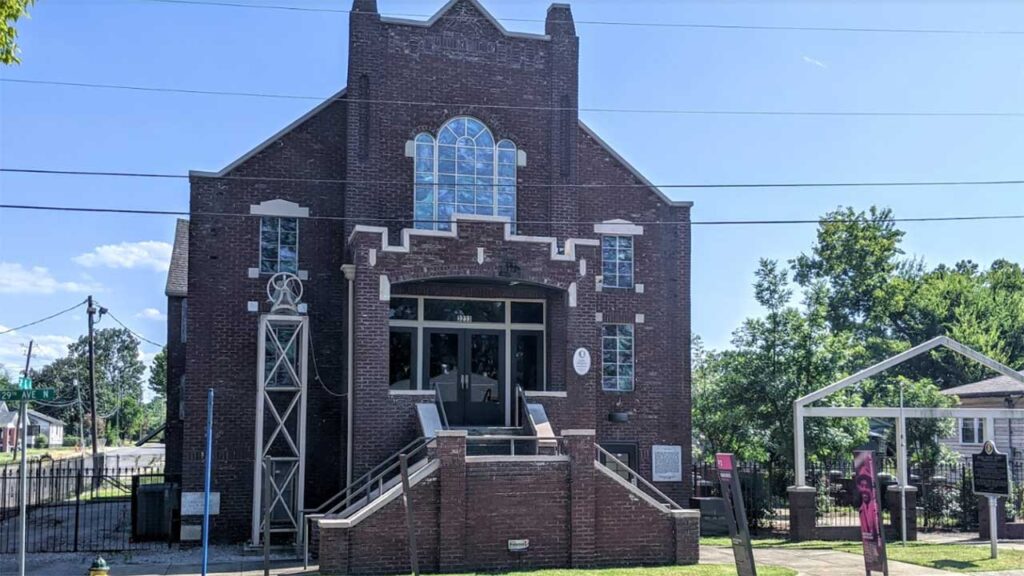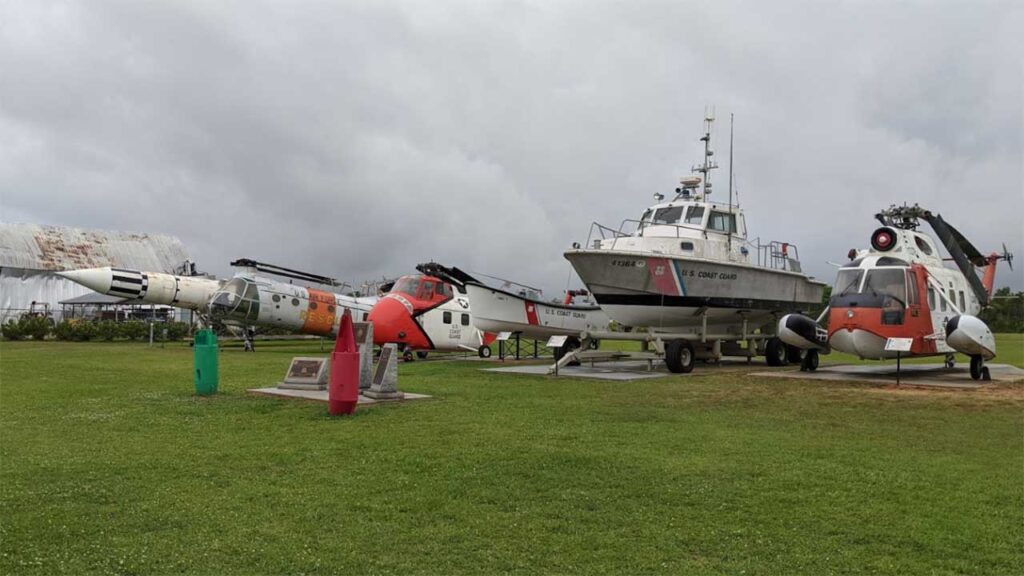Alabama has witnessed several historical occurrences. Fortunately, numerous historical sites dispersed around Alabama allow us to learn everything there is to know about the state’s past. History aficionados will like everything Alabama has to offer, from iconic Civil Rights Movement monuments to World War II-era ships and some of the country’s oldest churches.
Although reading about Alabama’s historical events and sites in a book is always an option, nothing beats experiencing them up and personal. These following historical sites in Alabama that are well worth visiting.
1. Bethel Baptist Church, Birmingham

Bethel Baptist Church is a historic church in Birmingham, Alabama’s which the first historical site in the Alabama Collegeville area. The Alabama Christian Movement for Human Rights (ACMHR), founded by Fred Shuttlesworth and active in Birmingham during the Civil Rights Movement, had its headquarters at the church from 1956 until 1961.
The church, which was completed in 1926, is a unique architectural blend of Gothic and Renaissance styles. The guardhouse and parsonage are vernacular ranch-style homes; the parsonage was erected in 1957 to replace the former parsonage, which was adjacent to the church and was bombed out in 1956.
You can get to know more about the oldest churches of US from this article.
2. Ivy Green, Tuscumbia

Ivy Green is a historic home museum in Tuscumbia, Alabama, located at 300 West North Commons. Helen Keller (1880–1968), the famed deaf-blind author and speaker, was born and raised in this house, which was built in 1820. It is currently a public museum and a National Historic Landmark commemorating Keller’s life. Helen Keller, a lady born deaf and blind who learnt to communicate via her instructor Anne Sullivan, was born in Ivy Green. By strolling about the property, you may get a sense of the interesting and inspiring narrative.
3. The U.S.S. Alabama, Mobile

The USS Alabama is a historical site in Alabama that was commissioned in 1942 and fought in the Pacific Theater during WWII. After participating in over 26 battles with the Japanese, the ship is one of just two remaining ships from this force. In 1943, she began her World War II exploits in the North Atlantic and then moved to the South Pacific. She ended up as a National Historic Landmark and a memorial to millions in Mobile, Alabama.
The National Historic Landmark WWII submarine USS DRUM sits in her cradle beside Mobile Bay (SS-228). The DRUM is the world’s oldest publically displayed American submarine. The Medal of Honor Aircraft Pavilion, located in the Battleship Memorial Park, houses a significant aircraft collection, vintage vehicles, and military memorabilia.
Check out the best museums in Alabama.
4. Bryce Hospital, Tuscaloosa
Bryce Hospital which is a known historical place in Alabama, first opened its doors in Tuscaloosa, Alabama, in 1861. It is the state’s oldest and largest psychiatric hospital. The structure is regarded as an architectural model. It was once known as the Alabama State Hospital for the Insane and subsequently as the Alabama Insane Hospital.
The hospital now has 268 beds for full-time (committed) patients who require acute care, treatment, and rehabilitation. A sister institution on the same property, the Mary Starke Harper Geriatric Psychiatry Hospital, provides an additional 100 beds for inpatient geriatric treatment. In 1977, the main structure was listed to the National Register of Historic Places.
5. Foster Auditorium, Tuscaloosa
On April 5, 2005, Foster Auditorium was designated as a National Historic Landmark. Foster Auditorium is most known for the “Stand in the Schoolhouse Door” incident, which occurred there more than any other event. The “Stand in the Schoolhouse Door” event took place at Foster Auditorium. Governor George C. Wallace stood at the doorway of the institution on the day of registration on June 11, 1963, making good on a campaign promise not to allow integration of the university as he was attempting to block two black students.
However, he failed to do so and had to step aside as he was pressurized by the federal government, Deputy United States Attorney general and others. The episode is seen as a watershed moment in the American Civil Rights Movement. In the 1994 film Forrest Gump, the scene was depicted (with artistic liberties used). The structure is a multi-purpose facility at Tuscaloosa, Alabama’s University of Alabama.
6. Moundville Archaeological Site, Moundville
The Moundville Archaeological Site, also known as the Moundville Archaeological Park, is a Mississippian culture archaeological site in Tuscaloosa, Alabama, on the Black Warrior River. Between the 11th and 16th centuries, the site was the political and ceremonial capital of a regionally structured Mississippian culture chiefdom polity, according to extensive archaeological study. The University of Alabama Museums manages the archaeological park component of the site, which spans 185 acres (75 ha) and includes 29 platform mounds arranged around a rectangular plaza.
In 1964, the site was designated as a National Historic Landmark, and in 1966, it was included in the National Register of Historic Places.
After Cahokia in Illinois, Moundville is the second-largest site in the United States from the classic Middle Mississippian period. The culture was manifested in towns and chiefdoms over the middle Mississippi River Valley, the lower Ohio River Valley, and much of the Mid-South, including Kentucky, Tennessee, Alabama, and Mississippi, which formed the core of the classic Mississippian cultural region. A museum and an archaeological laboratory are located in the park.
You might also like to visit these waterfalls in the Alabama.
7. Gaineswood, Demopolis
Another well known historical place in Alabama is Gaineswood. It is known as a plantation home which is located near Demopolis, Alabama. It is the most opulent plantation home ever erected in Marengo County and one of Alabama’s most important examples of Greek Revival architecture.The house was erected using the proceeds of forced labour, and enslaved workers did the majority of the work. After nearly 20 years of construction, it was finished on the eve of the American Civil War.
The Alabama Historical Commission is now running the house and grounds as a historic house museum.
8. Henry D. Clayton Home, Clayton
Henry De Lamar Clayton, Jr. (1857-1929), a lawmaker and judge, was born and raised at the Henry D. Clayton House, a historic plantation house in Clayton, Alabama. Clayton rose to fame as the architect of the Clayton Antitrust Act of 1914 while sitting in the United States Congress. This statute made it illegal to engage in certain forms of behaviour that were judged to be detrimental to a competitive market.
In 1914, he was appointed as a Federal District Judge, where he became known as a proponent of judicial reform. His father, Confederate General Henry DeLamar Clayton, Sr., erected the mansion. On December 8 1976, it was designated as a National Historic Landmark.
9. Dexter Avenue Baptist Church, Montgomery
Dexter Avenue Baptist Church is a Progressive National Baptist Convention-affiliated Baptist church in Montgomery which is an important historical place in Alabama. Because of its significance in the civil rights struggle and American history, the church was recognized as a National Historic Landmark in 1974.
The formal name was changed to the Dexter Avenue King Memorial Baptist Church in 1978 in honour of Dr Martin Luther King Jr., who served as pastor there and was instrumental in organizing the Montgomery bus boycott in 1955 during the civil rights period. The Alabama State Capitol is just a short distance away from the chapel.
Because of its historical significance, the US government submitted the church to UNESCO on January 1, 2008, as part of a planned future World Heritage Site proposal. The UNESCO “Tentative List of World Heritage Sites” includes it.
10. Kelly Ingram Park, Birmingham
Kelly Ingram Park, originally known as West Park, is a four-acre (1.6-hectare) park in Birmingham, Alabama. The Birmingham Civil Rights District is defined by 16th and 17th Streets, as well as 5th and 6th Avenues North. During the American Civil Rights Movement of the 1960s, the park, located just outside the doors of the 16th Street Baptist Church, served as a key staging area for large-scale protests. The events that unfolded in Kelly Ingram Park depicted the realities of police dogs and fire hoses being used against civil rights activists in the 1960s.
In 1932, the park was named for local fireman Osmond Kelly Ingram, who was the first US Navy sailor killed in World War I. To coincide with the establishment of the Birmingham Civil Rights Institute, an interpretative museum and research centre, which adjoins the park to the west, it was entirely restored and rededicated in 1992 as “A Place of Revolution and Reconciliation.”
11. Houston Historic Jail, Houston

The Houston Jail is a historic place in Houston, Alabama, in Winston County. On June 5, 1975, it was listed on the National Register of Historic Places. The structure is the only known remaining log prison in the state, as well as the sole public structure from when the county seat was in Houston. Architectural historians believe it was erected about 1868, at the same time as the now-destroyed courthouse was built.
Houston was designated as the seat in 1858, but the minutes of a grand jury meeting in 1867 said that a courtroom and jail were needed. Houston shrank to the little unincorporated hamlet it is today when the county seat was transferred to Double Springs in 1884.
12. Stevenson Railroad Depot, Stevenson
In Stevenson, Alabama, the Stevenson Railroad Depot and Hotel is a historic railroad station and hotel. The Memphis and Charleston Railroad and the Nashville and Chattanooga Railroad, whose routes met at Stevenson, collaborated on the project in 1872.
When the Southern Railway bought the Memphis & Charleston in 1898, the Louisville and Nashville Railroad (which had bought the N&C in 1880) took over the terminal and ran it until 1976. In 1982, it was transformed into a historical museum. Both structures are made of brick and have gable roofs with Italianate features. In 1887, a central, second-story tower was erected to the depot.
The first floor of the three-story hotel included a lobby, dining area, and kitchen, with the higher floors housing eight spacious guest rooms. In 1975, the structures were included in the Alabama Register of Landmarks and Heritage, and in 1976, they were added to the National Register of Historic Places.
13. Richards-DAR House, Mobile
The Richards DAR Home, located in Mobile, Alabama, is a historic house museum. For Charles and Caroline Richards, the Italianate-style home was constructed in 1860. The De Tonti Square Historic District, which was added to the National Register of Historic Places on February 7, 1972, is a contributing property.
The home is jointly operated and maintained by Mobile’s four Daughters of the American Revolution (DAR) chapters. Architectural historians consider it to be one of Mobile’s most well-preserved and ornate examples of mid-nineteenth-century residential architecture.
14. Fort Morgan – Fort Morgan
Fort Morgan is a historic brick pentagonal bastion fort located near the entrance of Mobile Bay in Alabama. It was erected on the site of the older Fort Bowyer, an earthen and stockade style fortress involved in the final ground engagements of the War of 1812. It was named after Revolutionary War hero Daniel Morgan. The fort was finished in 1834, and the first garrison arrived in March of that year.
Fort Morgan is located at the western end of State Route 180, at the tip of Mobile Point (Alabama). Mobile Bay is surrounded by it and Dauphin Island, which is home to Fort Gaines. The site is maintained by the Alabama Historical Commission.
15. Union Station – Montgomery
In Montgomery, Alabama, the Montgomery Union Station and Trainshed is a historic old railroad station. Rail service to the station, which was built in 1898 by the Louisville and Nashville Railroad, terminated in 1979, and it has subsequently been converted for use by the Montgomery Area Visitor Center and commercial tenants. In 1973, it was included on the National Register of Historic Places, and in 1976, it was designated as a National Historic Landmark.
16. Sloss Furnaces National Historic Landmark
Sloss Furnaces is a National Historic Landmark located in Birmingham, Alabama, USA. From 1882 to 1971, it was a pig iron-producing blast furnace.
17. Helen Keller Birthplace
Ivy Green is a historic house museum located at 300 West North Commons in Tuscumbia, Alabama. It was built in 1820 and served as the birthplace and childhood home of Helen Keller, who rose to prominence after overcoming deaf-blindness to communicate; she went on to become an author and public speaker.
18. The Edmund Pettus Bridge
In Selma, Alabama, the Edmund Pettus Bridge carries US Route 80 Business across the Alabama River. It was named after Edmund Pettus, a former Confederate brigadier general, U.S. senator, and state-level leader of the Alabama Ku Klux Klan, who died in 1940.
Alabama has a wide range of family-friendly places that are ideal for a summer day excursion. The state is rich in history, and there’s no better way to learn about it than by visiting some of the most intriguing historical places in the state. Several Alabama communities that saw historic events are still prospering today. Some of these communities are also among the state’s oldest.

